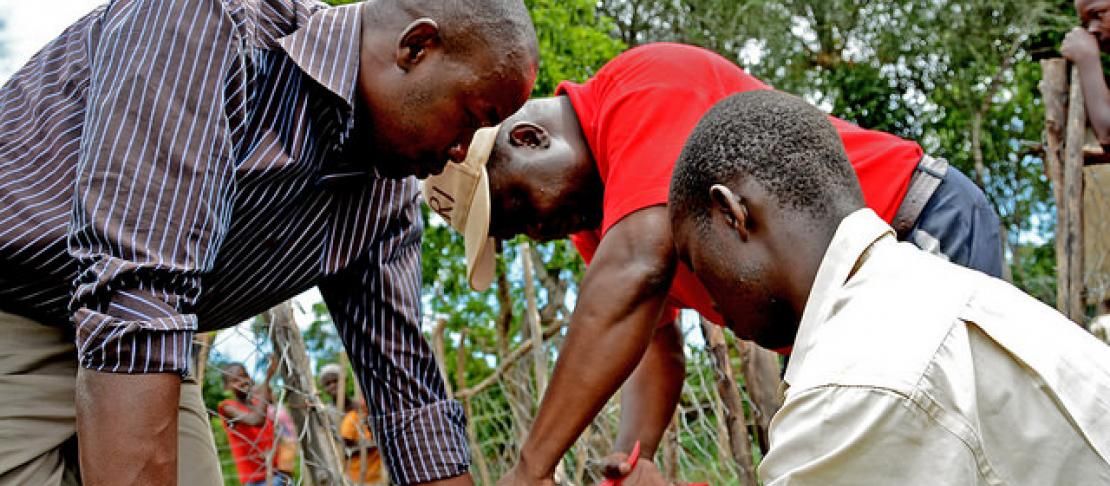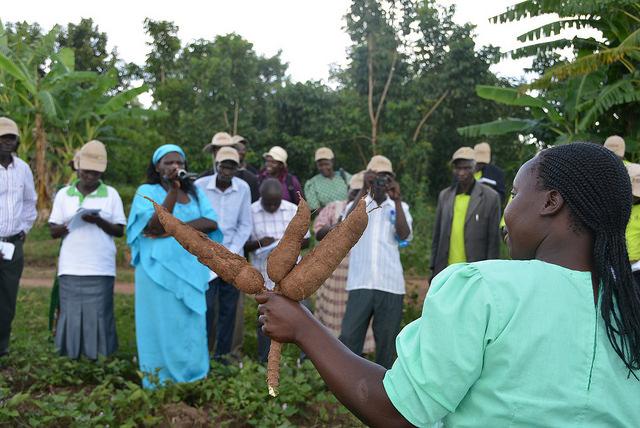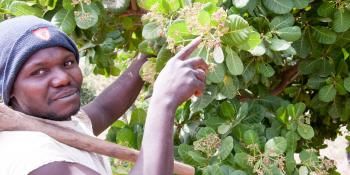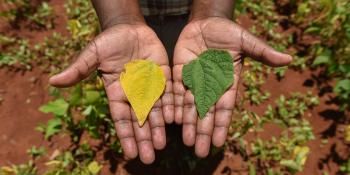Inspiring action: Nyando climate-smart villages host policy makers

A group of farmers is reaching out to policy makers in Africa, sharing with them lessons from their journey to attaining food secure households.
In November 2013, Rachel Kyte, the World Bank Group Vice President and Special Envoy for Climate Change visited the Nyando climate-smart villages in western Kenya. Rachel was able to see first-hand what smallholder farmers working closely with researchers and other partners are doing to move out of poverty and build resilience, as well as to find ways to reduce emissions from agriculture.
Since the visit in 2013, Nyando farmers have continued to host a number of people, among them policy makers, interested in learning about their climate-smart interventions.
Nyando is one of the CGIAR Research Program on Climate Change, Agriculture and Food Security (CCAFS) climate-smart villages (CSVs) in East Africa. Working with a mix of partners, CCAFS East Africa is developing the Nyando CSVs to test climate-smart agricultural interventions. The aim is to boost farmers’ ability to adapt to climate change, manage risks and build resilience. At the same time, the hope is also to improve livelihoods and incomes and, where possible, reduce greenhouse gas emissions to ensure solutions are sustainable. Nyando is in an area that has been identified as high at risk from the effects of climate change.
Sharing lessons: Climate-smart interventions
In 2014, 13 officials from the Ethiopian government visited the Nyando CSVs. The officers included livestock and crop specialists, program coordinators, soil fertility management experts, a monitoring and evaluation specialist, post-harvest technologies and processing experts, directors of regional bureaus of agriculture, and agricultural extension specialists. The tour was organized by the USAID- CIAFS (Capacity to Improve Agriculture and Food Security Project) in order to provide the officers an opportunity to explore how appropriate climate-smart agriculture (CSA) practices in the Nyando community can be replicated and scaled out in Ethiopia.

Learning visits ensure lessons are shared with all stakeholders including farmers and policy makers. Photo: s. Kilungu (CCAFS)
Farmer John Obuom and his wife Poline talked to the delegation about their diverse one hectare farm, on which they plant vegetables and legumes. Additionally, they keep sheep, goats and chicken to boost the family's food supply and nutrition. The farm is located in a place where land is scarce and much of the existing area has been degraded by floods that carry away top soil leading to loss of productive soil and the formation of deep gullies. Having restored a large part of the previously degraded land, this family is combining flood water harvesting into four water pans with capacities ranging from 70,000 to 90,000 litres for irrigation during the dry season.
John practices intercropping of food crops and fruit trees to maximize land use (pawpaws, tomatoes and local vegetables). In the past, he worked with the CGIAR’s World Agroforestry Centre (ICRAF) to restore his degraded land. Using species screened through on-farm research, he established tree woodlots to control soil and water movement and rehabilitated previously degraded areas for crop production. He is now able to supply seeds and seedlings to other farmers and his woodlot ensures that he is on the way to complying with the Kenya government policy requiring each farmer to establish 10% of their land holding with trees.
Watch the video showing John Obuom's interventions:
In addition, he is a good example amongst farmers who are ready to participate in Nationally Appropriate Mitigation Action (NAMA) programs. As a food security measure, he is working with researchers to test and multiply cassava planting material developed in collaboration with the International Institute of Tropical Agriculture (IITA) that resists the deadly mosaic virus disease. He also grows the early maturing pigeon peas as a protein supplement. Pigeon pea is a new crop in Nyando.
Mr. Obuom has also diversified into better adapted breeds of small livestock to meet food security and income needs of his household. He is one of the farmers working with the International Livestock Research Institute (ILRI) to test sheep and goat breeds that will better adapt to changing climatic conditions in Nyando. These include Gala goats which mature and reach market weight faster than indigenous stock of East African goats and Red Maasai sheep that tolerate heat and internal parasites. He now has over 10 goats. Many other farmers have benefited through a ‘passing on the gift’ initiative introduced by CCAFS and World Neighbors where farmers receive Gala goats for crossbreeding with the small East African indigenous goats. The offspring (six month to one year) are given to other neighbors for purposes of crossbreeding ensuring everyone in the village benefits.
Stop two: greenhouse farming with youth groups
Visitors to Nyando always encounter youth groups engaged in smart farming in half hectare fields. The Ethiopian delegation visited the Lower Kamula Youth Group. Here, they learnt how to deal with the challenges of degraded land, declining land sizes and seasonal rainfall variability though adoption of smart farms. A key feature of smart farms is the shift to greenhouse farming (enclosed spaces of up to one quarter of a hectare, covered with polythene and combined with drip irrigation lines). Compared to open fields, greenhouses offer the advantage of use of less water, better control over pests, diseases, floods and drought. Next to the greenhouse, the youth group had established two water pans with a total capacity of over 250,000 litres having over 2,000 tilapia fish. Additionally, crops that included kales, cowpeas and black night shade were planted under drip irrigation.
The smart farms serve as demonstration sites for youth and women groups engaged in agriculture. Due to the nature of the intensive knowledge and skills required to operate greenhouse production units, CCAFS partners train youth groups as part of the process of advancing local adaptation actions. Jack Awuor explained to the visitors:
Before establishment of the smart farm, our members were involved in sand harvesting from the adjacent River Asawo which accelerated expansion of gulleys and degradation of riverine vegetation. Now we have tomatoes in the greenhouse and other vegetables in the open field. The fish provide an additional source of income.
View photos of the Ethiopian delegation interacting with the Lower Kamula group:
Empowering the villagers through community based organizations
At a third stop, the visitors got an opportunity to better understand the role of Community Based Organizations (CBOs) in helping farmers increase their capacity to adapt through collective action. Edward Ouko, a farmer and CBO leader explained how an innovation fund had helped establish a farm input supply shop. The CBO partnered with a local agro-dealer, bringing improved seeds and fertilizers closer to the farmers.
Read more: Empowering a local community to address climate risks and food insecurity in Lower Nyando, Kenya
Researchers, farmers and government officers working in Nyando and other CSVs continue to monitor and evaluate the various enterprises with an aim to scale up and share emerging lessons widely. In 2015, more learning visits will be held. This includes a visit by officers from the Ministry of Agriculture and Animal Resources in Rwanda working under the IFAD supported Climate Resilient Post-Harvest and Agribusiness Support Project.
To receive updates from the region, follow us on twitter - @cgiarclimate_ea and subscribe to our quartely newsletter - The SmartAG Partner.
John Recha is a Post Doctoral Fellow, Participatory Action Research, with CCAFS East Africa. Edited by Vivian Atakos, Communication Specialist, CCAFS East Africa.



